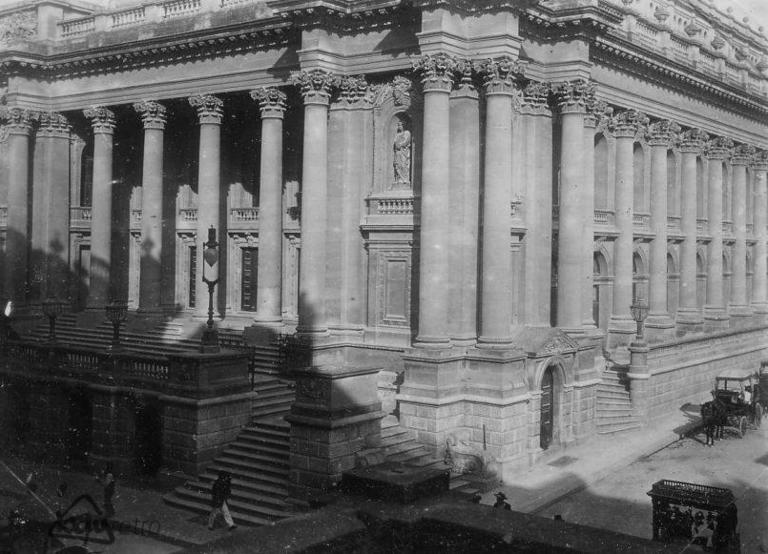Our legacy enables us to better understand our forefathers and should be regarded as our most valuable cultural asset. Unfortunately, natural disasters and conflicts have made it impossible to pass forward this legacy.
Many historic buildings, religious and architectural sites have been targeted in wars or terrorist attacks over the years. As a result, we are losing our cultural and spiritual legacy as a result of human struggle.
Palmyra, Syria

During Syria’s civil war in 2015, the Islamic State of Iraq and Syria (ISIS) destroyed large areas of the UNESCO World Heritage Site Palmyra, including several valuable archaeological monuments such as the Temple of Baalshamin, Monumental Arch, and Tower of Elahbel. The destroyed Arc of Triumph of Palmyra was recreated in London’s Trafalgar Square in 2016.
In 2020, Russian researchers created a three-dimensional digital model of Palmyra and began restoration work in collaboration with UNESCO and Syria’s Department of Antiquities and Museums.
Aleppo, Syria

The ISIS capture of Aleppo, Syria’s oldest city, in 2015 also destroyed many cultural and other heritage monuments. This includes the Citadel, a UNESCO World Heritage Site that was extensively destroyed as a result of ISIS and Syrian troops’ usage of it. The castle was formerly one of the world’s largest and oldest, dating back to the third millennium BC. While it has seen numerous civilisations, including Greek, Byzantine, Ayyubid, and Mamluk, a large portion of its construction was completed during the Ayyubid period in the 12th and 13th centuries.
Timbuktu’s religious sites, Africa

Many religious and historical sites in Timbuktu, Mali, including multiple Sufi saints’ graves and mausoleums, mediaeval shrines, and the 15th century Sidi Yahya mosque, were assaulted and demolished in 2012 by Malian jihadist Ahmad al-Faqi al-Mahdi. As a result, the International Criminal Court (ICC) heard the first-ever war crime prosecution for the destruction of a cultural monument in 2016.
UNESCO reports that 14 of Timbuktu’s damaged mausoleums were reconstructed by 2015 using traditional construction methods and UNESCO financing.
The Buddhas of Bamiyan, Afghanistan

Before being destroyed by the Taliban in 2001, the Buddhas of Bamiyan were the highest standing sculptures in the world, with one rising at 55 metres. They were important examples of the Gandharan style of Buddhist art in Central Asia. Since the 6th century, the sculptures have served as a major landmark on the renowned Silk Road.
The Taliban, led by Mullah Mohammed Omar, utilised tanks, artillery rounds, and explosives to destroy the cultural relics.
Beijing’s Old Summer Palace, China

During the Second Opium War in 1860, British and French forces completely destroyed the exquisite Qing Dynasty residence complex. The compound, built in the 18th and early 19th centuries, included tall temples and pavilions surrounded by beautiful, exotic gardens.
The Former Prefectural Industrial Promotion Hall, Japan
 Hiroshima was home to Japan’s old Prefectural Industrial Promotion Hall, designed by Czech architect Jan Letzel and built in 1915. It was used to showcase and sell provincial items, as well as to host art displays and other expositions. However, while the war raged on, a number of government departments sought refuge in the Hall.
Hiroshima was home to Japan’s old Prefectural Industrial Promotion Hall, designed by Czech architect Jan Letzel and built in 1915. It was used to showcase and sell provincial items, as well as to host art displays and other expositions. However, while the war raged on, a number of government departments sought refuge in the Hall.
It was severely damaged when the United States Air Force launched the first atomic bomb on it in 1945. The ruins of the A-Bomb Dome Hall are now part of the Hiroshima Peace Memorial Park.
The Park was included on the UNESCO World Heritage Sites list in 1996 as a symbol of the continuation of international peace.
Malta’s Royal Opera House, Valletta

The Royal Opera House, constructed by English architect Edward Middleton Barry and opened in 1866, is one of Malta’s most captivating and recognisable structures. Unfortunately, it was destroyed by bombs dropped by the Luftwaffe of Germany during World War II in 1942.
Several attempts have been made in the past to reconstruct the theatre. Finally, in 2013, an open-air theatre known as Pjazza Teatru Rjal was created within the ruins of the Royal Opera House to preserve cultural legacy.
Jonah’s Tomb, Iraq

Jonah’s Tomb, also known as The Mosque of the Prophet Younis, was regarded the biblical prophet’s final resting place and one of the most important holy places for both Christians and Muslims. It was constructed in the eighth century in Mosul, Iraq.
However, in 2014, the entire religious site was blown up by ISIS, who said the crime was carried out in protest of the mosque, which had become a centre of apostasy rather than a place of worship. In reality, numerous surrounding homes were also damaged as a result of the incident.
St. Michael’s Old Cathedral, United Kingdom

The magnificent Gothic church in Coventry, United Kingdom, was constructed in the late 14th and early 15th centuries. It was built in the twelfth century as a chapel for the Earl of Chester’s castle, but was later enlarged in the late fourteenth century to become England’s biggest parish church. In 1918, it was designated as a cathedral.
However, during World War II, the Germans severely destroyed the Cathedral, leaving just the spire, tower, and outside walls remaining.



















































































